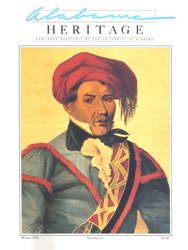|
On the cover: Tustennuggee Emathla, or Jim Boy, helped lead the Redstick rebellion. (From McKenney and Hall, History of the Indian Tribes of North America, vol. II, 1842)
|
FEATURE ABSTRACTS
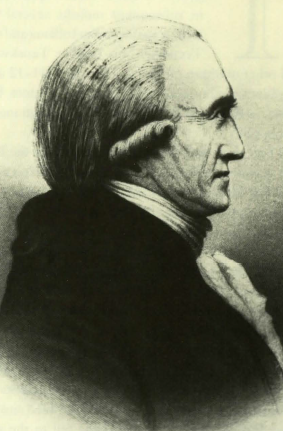 U.S Indian Agent Benjamin Hawkins spent two decades promoting his culture's version of civilization to the Indians. Redstick prophets, preferring Indian civilization, named
Hawkins a prime target for execution in 1813. (Courtesy
Alabama State Department of Archives and History)
U.S Indian Agent Benjamin Hawkins spent two decades promoting his culture's version of civilization to the Indians. Redstick prophets, preferring Indian civilization, named
Hawkins a prime target for execution in 1813. (Courtesy
Alabama State Department of Archives and History)
The Creek Prophetic Movement
By Joel W. Martin
In 1914 a group of Creek rebels known as the Redsticks attempted to revolt against the United States government. Spurred on by prophets and alarmed by natural disasters such as earthquakes, these poorly armed Native American warriors fought against a coalition of whites, Cherokees, and Creeks--only to be defeated on March 27 in the Battle of Horseshoe Bend, the costliest battle in the history of warfare between the United States and Native Americans.The story of this rebellion remains a notable part of Creek history.
Additional Information
Wright, James Leitch, Jr. The Only Land They Knew: The Tragic Story of the American Indians in the Old South (The Free Press, 1981).
About the Author
Joel Martin, professor of religious studies at Franklin and Marshall College, holds degrees from Birmingham-Southern, Harvard Divinity School, and Duke University. The Opelika native is currently a Fellow at the Center for the Study of American Religion at Princeton University.
By Joel W. Martin
In 1914 a group of Creek rebels known as the Redsticks attempted to revolt against the United States government. Spurred on by prophets and alarmed by natural disasters such as earthquakes, these poorly armed Native American warriors fought against a coalition of whites, Cherokees, and Creeks--only to be defeated on March 27 in the Battle of Horseshoe Bend, the costliest battle in the history of warfare between the United States and Native Americans.The story of this rebellion remains a notable part of Creek history.
Additional Information
- Hawkins, Benjamin. Letters, Journals, and Writings of Benjamin Hawkins, edited by C. L. Grant, 2 vols. (Beehive Pres , 1980).
- Hudson, Charles. The Southeastern Indians (University of Tennessee, 1976).
- Martin, Joel. Sacred Revolt: The Muskogees' Struggle for a New World (Beacon Press, 1991).
Wright, James Leitch, Jr. The Only Land They Knew: The Tragic Story of the American Indians in the Old South (The Free Press, 1981).
About the Author
Joel Martin, professor of religious studies at Franklin and Marshall College, holds degrees from Birmingham-Southern, Harvard Divinity School, and Duke University. The Opelika native is currently a Fellow at the Center for the Study of American Religion at Princeton University.
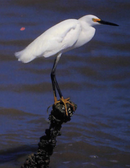 The great egret, snowy egret, and white ibis are often found in rookeries with cattle egret. (Photograph by Robin McDonald)
The great egret, snowy egret, and white ibis are often found in rookeries with cattle egret. (Photograph by Robin McDonald)
The Cattle Egret
By William H. Allen, Jr.
Late in the nineteenth century, a remarkable migration took place. The cattle egret, a native of Africa, migrated across the Atlantic. They were first sighted in South America, but as the years passed the egret moved northward; by 1957 they had reached Alabama. This remarkable bird has demonstrated astounding adaptability and provides bird watchers with a nigh-limitless source of fascination.
Additional Information
Dusi, Julian L., and Rosemary T. Dusi. "The Status of the Cattle Egret in Alabama 1966," Alabama Birdlife, 15: 2-6.
About the Author
William H. Allen, a retired professor from Auburn University's School of Business, now devotes his rime to free-lance writing and photography.
By William H. Allen, Jr.
Late in the nineteenth century, a remarkable migration took place. The cattle egret, a native of Africa, migrated across the Atlantic. They were first sighted in South America, but as the years passed the egret moved northward; by 1957 they had reached Alabama. This remarkable bird has demonstrated astounding adaptability and provides bird watchers with a nigh-limitless source of fascination.
Additional Information
Dusi, Julian L., and Rosemary T. Dusi. "The Status of the Cattle Egret in Alabama 1966," Alabama Birdlife, 15: 2-6.
- Heminway, John. Smithsonian (May 1987), 60-69.
- Imhof, Thomas A. Alabama Birds (University of Alabama Press, 1976).
- Peterson, Roger Tory. National Geographic Magazine (August 1954), 281-92.
About the Author
William H. Allen, a retired professor from Auburn University's School of Business, now devotes his rime to free-lance writing and photography.
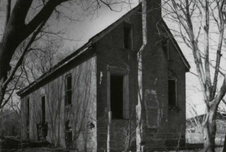 This abandoned 1820 brick Tidewater-type house, Colbert County, could be restored.
This abandoned 1820 brick Tidewater-type house, Colbert County, could be restored.
Endangered Aristocrats
By Robert Gamble
Alabama's Tennessee Valley claims the largest surviving concentration of Williamsburg-type cottages in the Deep South. These houses have steadily dwindled in number until perhaps no more than a dozen clear-cut examples stand today. These houses provide valuable insight into the process of cultural transference, as well as being in themselves worthwhile examples of a historic form of architecture.
Additional Information
About the Author
Robert Gamble is senior architectural historian, Alabama Historical Commission. His 1987 guide to Alabama architecture (listed above), based on the Historic American Buildings Survey collections, Library of Congress, won the Antoinette Forrester Downing Award given annually by the Society of Architectural Historians.
By Robert Gamble
Alabama's Tennessee Valley claims the largest surviving concentration of Williamsburg-type cottages in the Deep South. These houses have steadily dwindled in number until perhaps no more than a dozen clear-cut examples stand today. These houses provide valuable insight into the process of cultural transference, as well as being in themselves worthwhile examples of a historic form of architecture.
Additional Information
- Buchanan, Paul E. "The Eighteenth-Century Frame Houses of Tidewater Virginia," in Building Early America edited by Charles E. Peterson (Chilton Book Co., 1976).
- Forman, Henry Chandlee. Virginia Architecture in the Seventeenth Century (Virginia 350th Anniversary Celebration Corp., 1957).
- Gamble, Robert. The Alabama Catalog--Historic American Buildings Survey: A Guide to the Early Architecture of the State (University of Alabama Press, 1987).
- Glassie, Henry. Pattern in the Material Folk Culture of the Eastern United States (University of Pennsylvania Press, 1968).
- Morrison, Hugh. "Southern Colonial Architecture," in Early American Architecture (Oxford University Press, 1952).
- Upton, Dell. "Vernacular Domestic Architecture in Eighteenth-Century Virginia," in Common Places: Readings in Vernacular Architecture (University of Georgia Press, 1986).
- Waterman, Thomas Tileston, and John A. Barrows. Domestic Colonial Architecture of Tidewater Virginia (Charles Scribner's Sons, 1932).
- Whiffen, Marcus. The Eighteenth-Century Houses of Williamsburg (Colonial William burg, 1960).
About the Author
Robert Gamble is senior architectural historian, Alabama Historical Commission. His 1987 guide to Alabama architecture (listed above), based on the Historic American Buildings Survey collections, Library of Congress, won the Antoinette Forrester Downing Award given annually by the Society of Architectural Historians.
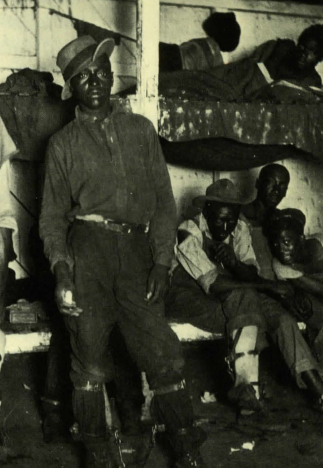 The "dull, hopeless misery" of convicts like these in a Birmingham jail inspired Julia Tutwiler to campaign resolutely for prison reform in Alabama. (Courtesy Birmingham Public Library Archives)
The "dull, hopeless misery" of convicts like these in a Birmingham jail inspired Julia Tutwiler to campaign resolutely for prison reform in Alabama. (Courtesy Birmingham Public Library Archives)
Julia S. Tutwiler: Years of Experience
By Paul M. Pruitt, Jr.
As a woman, Julia Tutwiler could neither vote nor hold office. Yet she changed the face of higher education in Alabama and forced prison reform on a reluctant state. In many ways, Tutwiler was the product of her age, yet she accomplished a tremendous amount of reform by working within the system she inherited. Part two of a series on the life of this remarkable woman. Part one is found in AH 22: "Julia Tutwiler: Years of Innocence."
Additional Information
Bynum, Rusty. Julia Tutwiler: The Pathfinder (Writers' Consortium Books, 1989).
About the Author
Paul Pruitt, a native Alabamian, holds a doctoral degree in history from William and Mary. A librarian at the University of Alabama School of Law, heal o reaches history at the university.
By Paul M. Pruitt, Jr.
As a woman, Julia Tutwiler could neither vote nor hold office. Yet she changed the face of higher education in Alabama and forced prison reform on a reluctant state. In many ways, Tutwiler was the product of her age, yet she accomplished a tremendous amount of reform by working within the system she inherited. Part two of a series on the life of this remarkable woman. Part one is found in AH 22: "Julia Tutwiler: Years of Innocence."
Additional Information
- Lyon, Ralph M. Julia Tutwiler (Alabama-Tombigbee Rivers Regional Planning and Development Commission, 1976).
- Moore, Eoline Wallace. "Julia Tutwiler, Teacher," Birmingham-Southern College Bulletin, XXVII (January 1934).
- Pannell, Anne Gary, and Dorothea E. Wyatt. Julia S. Tutwiler and Social Progress in Alabama (University of Alabama Press, 1961).
Bynum, Rusty. Julia Tutwiler: The Pathfinder (Writers' Consortium Books, 1989).
- Cooper, Richard. Julia Tutwiler: Teacher, Leader (Creative Productions, 1987).
About the Author
Paul Pruitt, a native Alabamian, holds a doctoral degree in history from William and Mary. A librarian at the University of Alabama School of Law, heal o reaches history at the university.
